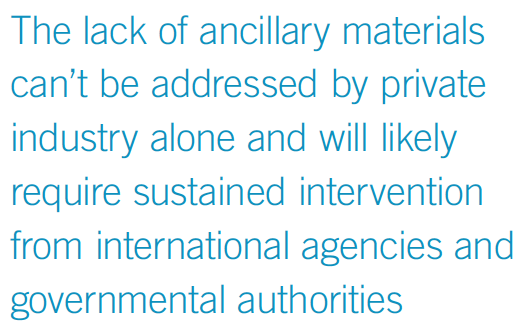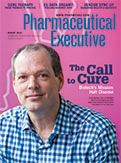High-Stakes Manufacturing: Mitigating the Risks
Pharmaceutical Executive
How to navigate the production and reimbursement intricacies of bringing regenerative medicines from bench to bedside.
Exploring the key strategies and steps in navigating the production and reimbursement complexities of bringing gene-based drugs from bench to bedside
Regenerative medicines-which are treatments that repair or replace the body’s own damaged or diseased tissues using cell or gene therapy, or tissue engineering-can treat severe, incurable, or chronic diseases that do not respond to conventional drugs.
Complete remission/response rates in clinical trials for the first two FDA-approved CAR T-cell medicines to treat cancers of the blood, Kymriah (tisagenlecleucel) and Yescarta (axicabtagene ciloleucel), reportedly ranged from 54% to 81%-results previously unheard of in the clinical settings studied. And Luxturna (voretigene neparvovec), a single-treatment gene therapy for patients with previously untreatable progressive vision loss due to an inherited genetic mutation, was approved by FDA after data showed it provided a working copy of the mutated gene, restored vision, and improved sight.
With at least 20 more new gene therapy products in late-stage development and more than 100 companies working on CAR T-cell therapies, the field of regenerative medicine is exploding.
Despite the exciting science and huge potential, developing regenerative medicines is difficult. Manufacturing can be lengthy, complex, and costly, especially when it involves genetically modifying and processing cells or genes. That’s because:
- Even small changes in manufacturing processes can negatively impact product quality and clinical outcomes.
- Some products are approved at small scale, but commercial scale operations require manufacturing controls to be in place.
- Shortages of high-quality ancillary materials (such as growth factors, nutrients, and reagents) are a major constraint.
Although regenerative medicines often qualify for expedited regulatory pathways, speeding development and review times, use of these mechanisms requires less clinical data. Curative therapies often show positive benefit-risk ratios after tests in a small number of patients-and their clinical benefits and production costs support high price points. However, sponsors must launch these products in a cost-constrained healthcare marketplace where payers want more data about benefits and side effects, not less, and may not fully reimburse until they have it.
Strategies to mitigate risks
1. Identify the clinically relevant quality attributes for cell and gene therapy products. Making changes to the process/product is an inevitable part of continually improving a product, especially for cell and gene therapies. However, manufacturers of these products often introduce major manufacturing changes-such as scale-up and automation-very late in the product’s development lifecycle.
This is risky because even small changes in manufacturing processes can potentially affect product quality, effectiveness, and ultimately, commercial success. That’s why FDA and other regulators strongly advise manufacturers to analyze and understand precisely the critical quality attributes (CQAs) of their drug.
CQAs are essential for the development of meaningful product specifications, which is how sponsors establish and ensure manufacturing quality and consistency. But identifying product-specific and clinically relevant CQAs is highly complex for regenerative medicines and requires a systematic, iterative approach.
2. Establish commercial-scale manufacturing controls prior to licensure. Historically, FDA has set the bar high for the chemistry manufacturing and controls (CMC) readiness of a licensed product. Sponsors must demonstrate the finished product can be manufactured consistently at commercial scale in accordance with a predetermined set of release specifications, and product quality can be maintained for the duration of its shelf-life. However, for cell and gene therapy products, FDA has been flexible as to what constitutes reasonable and scientifically-justified quality controls and metrics. In some cases, products are approved at small manufacturing scale and manufacturers sometimes struggle to meet their own proposed release specifications post-approval.
Manufacturing controls must be established at commercial scale prior to licensure if sponsors are to ensure regenerative medicines are available to patients. To achieve this, CMC should be embedded in clinical development in a way that makes process validation and control a priority earlier in the product lifecycle than ever before.
Manufacturers should automate the entire process, or at least attempt to automate distinct unit operations which are critical to consistent manufacturing of a high-quality product.
3. Support public-private consortiums focused on producing ancillary materials. Manufacturers of gene therapies struggle to procure essential ancillary materials in a sustainable, cost-effective manner. Establishing a reliable supply chain requires not only following the Current Good Manufacturing Practices (CGMPs) for materials, and vendor qualifications and quality agreements that are required for marketing authorization, but also ensuring the long-term reliability of the supply chain.

There is a significant shortage of high-quality ancillary materials in the market today. This shortage-expected to worsen as increasing numbers of regenerative medicines are commercialized over the next decade-is due to the limited availability of natural resources, the cost of manufacturing, and susceptibility to many outside threats and competition.
The lack of ancillary materials can’t be addressed by private industry alone and will likely require sustained intervention from international agencies and governmental authorities. Companies should actively support public-private consortiums to solve the problem.
4. Consider alternative reimbursement schemes. Therapies that cure or reverse diseases can generate substantial downstream cost savings for healthcare systems and thus can be cost-effective at very high per-patient prices.
For payers, determining the reimbursement value of a single-treatment therapy with curative potential is challenging since that requires the entire cost of treatment be paid upfront. It is especially difficult if there is uncertainty about efficacy due to lack of long-term follow-up data or real-world evidence (RWE).
In response to this challenge, payers have increasingly turned to new contracting arrangements, including performance-based reimbursement, indication-specific pricing, dynamic pricing, and budget caps, which have been extensively used for regenerative medicines. For example:
- Strimvelis, an ex vivo stem cell gene therapy to treat rare disease ADA-SCID, known as “bubble boy syndrome,” was launched in Italy with a full “money-back guarantee.” The €594,000 per patient cost of treatment will not apply if it doesn’t work.
- In the US, Kymriah was launched with an outcomes-based approach. The Centers for Medicare and Medicaid Services (CMS) was to pay only for patients who respond to Kymriah by the end of the first month ($475,000 per responder). In both England and Germany, Kymriah is subject to a dynamic pricing agreement where temporary reimbursement has been granted pending collection of real-world and clinical trial data.
- In January, BlueBird Bio proposed a leasing-type agreement for Zynteglo, a putative curative therapy for beta-thalassemia approved in Europe in June.
Although there have been notable failures-such as the UK’s risk-sharing scheme for multiple sclerosis drugs-nontraditional reimbursement strategies and pay-for-performance schemes are realities for which developers now must plan.
Mo Heidaran is Vice President, Technical – Regulatory, Parexel. Richard Macaulay is Senior Director – Access, Parexel

Is Artificial Intelligence a ‘Product’? Products Liability Implications for AI-Based Products
April 10th 2025As the physical products we use evolve to become increasingly complex, traditional products liability frameworks may not always fit to provide remedies for harm that can result from using novel product types.